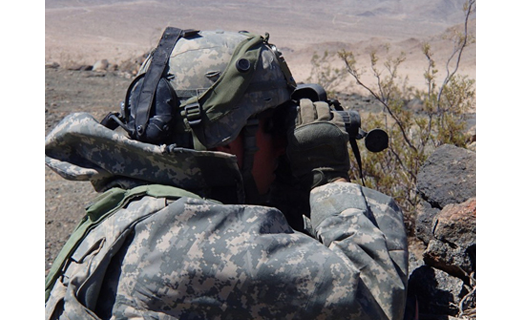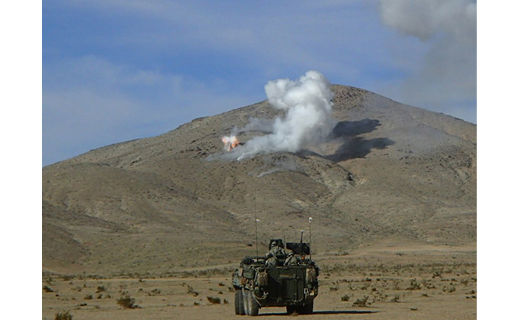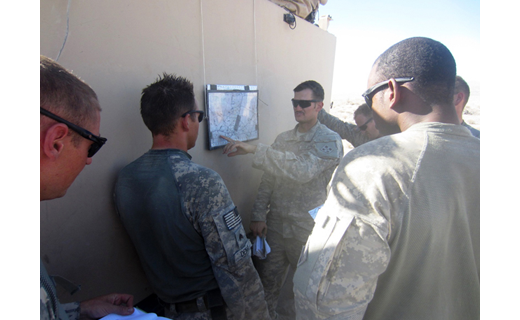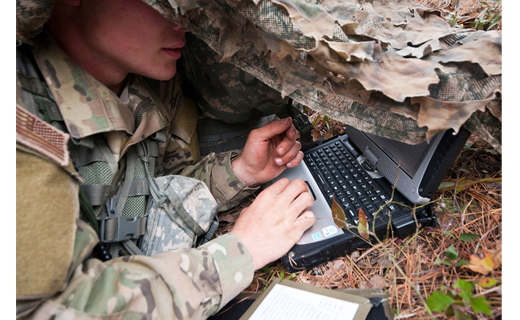Platform Immaterial: Reconnaissance Challenges in a Decisive-Action Training Environment

of the division’s 4th Brigade Combat Team at Fort Bliss, Texas, Oct. 20, 2005.
(Photo by SPC Paula Taylor)


(Photo by CPT Jaison Desai)

must place a renewed emphasis on training from the OP backward.
As the Army continues the drawdown in Afghanistan, the combat training centers (CTCs) are transitioning brigade combat team (BCT) training exercises to the decisive-action training environment (DATE) to better prepare for global contingencies. Faced with a hybrid threat of both conventional and asymmetric elements, and a recent history focused on urban warfare and stability operations, BCTs are struggling with many facets of the DATE scenarios. Nowhere is this more prevalent than in cavalry organizations, which are now able to refocus on core tactical tasks and competencies but are also challenged by historic issues associated with operating forward of main defensive positions, stretched supply lines and multiple threat scenarios.
Four DATE training rotations analyzed here featured an ideal cross-section of Army capabilities – an armored brigade combat team (ABCT) at the National Training Center (NTC), an airborne infantry regiment at the Joint Readiness Training Center (JRTC), a Stryker brigade combat team (SBCT) at NTC and the proof-of-concept for the proposed 6x36 formation (six Bradleys, 36 Soldiers per platoon). Though each organization had its own unique challenges, trends emerged across all units regardless of platform used. This indicates a need to address these issues across the entirety of the cavalry world to improve capabilities in support of maneuver forces. While certainly not extensive, the following observations highlight some of the more striking challenges within each warfighting function and are generally focused at the troop level to allow junior leaders to improve the organization as a whole.
Movement and maneuver
The shift to decisive action (DA) means that cavalry forces are once again being relied on to complete their doctrinal tasks in support of the BCT. Even though leaders generally have an understanding of the fundamentals of reconnaissance and the basic requirements for conducting operations such as zone reconnaissance and screen, the details and proficiency of these operations are still a struggle in many cases. This is likely attributable to a simple lack of training time and emphasis for our Army and will undoubtedly improve as increasing numbers of units conduct DATE exercises. Furthermore, the lack of fundamental training and employment of dismounts continues to plague the cavalry. Even with the SBCT’s Javelin-heavy formation and the proposed 36-man platoon – which is specifically designed to provide long-duration dismounted observation posts (OP) – units struggle with using their scouts for anything more than local security. As a formation, we must begin training from the OP backward instead of focusing our attention on the vehicular platform.
While terrain and reconnaissance focus clearly play the critical role in determining the width of a zone or screen for a troop, a general reference is between six to 10 kilometers of frontage for a standard ABCT troop and 18-30 kilometers for a squadron. Units still struggle to achieve appropriate frontage and suffer from a lack of depth across that frontage. Commanders need to remember that “the term ‘screen line’ is descriptive only of the forward trace along which security is provided.”1 Too often, the troop will spread its vehicles and dismounts in essentially a straight line exactly on top of the phase line representing their screen. During one rotation, the troop emplaced along the screen line, then asked to move forward of the ground limit of advance (LoA) to emplace obstacles. Obviously, this request was denied as it was forward of the LoA, yet the troop did not identify it could move backward by 500 meters to a perfect intervisibility line that concealed their positions and allowed emplacement of obstacles forward.
During any type of maneuver, the troop must treat its operation as reconnaissance and provide appropriate focus to its elements. The cavalry unit may still move rapidly and reposition in support of various follow-on missions without compromising its own security while providing valuable information to higher echelons. This is especially true in a hybrid-threat environment, where asymmetric forces and foreign sympathizers will blend into the civilian population and report via commercial radios or cellular networks to enemy conventional forces. Deliberate maneuver is key to maintaining operational security and reacting to threats. Doctrine reinforces this concept by discussing in detail the planning requirements and organization of an element during a tactical road march (TRM). Many units equate a TRM with an “administrative move,” resulting in a loss of situational awareness and tactical bearing. In reality, a TRM is a deliberate operation involving a reconnaissance party and quartering party moving by infiltration.2 This ensures security and trafficability of the route, along with suitability of the final tactical assembly area (TAA) position upon arrival.
Intelligence
The job of a scout is to gather data in support of specified information requirements (SIRs) to allow the brigade to answer priority intelligence requirements (PIRs). To effectively accomplish this task, the unit must complete a PIR crosswalk down to the individual-Soldier level. Formations struggle with taking the highly generalized brigade PIR and refining them to the troop level. The troop commander must go the extra step and further refine these PIRs into indicators a junior scout on an OP can answer. An indicator of “groups of six or more armored vehicles” allows the most junior Soldier to easily identify and report observation to higher echelons. The staff can then tie the indicator to the appropriate PIRs, answer these PIRs and report to the brigade.
The scout is only as good as his eyes and comprehension of what he is observing when trying to identify the enemy. While our most sophisticated surveillance platforms allow us to see a great distance, they do not come with the analytical tools to discern the type of vehicle the scout is observing. Combat-vehicle identification was once a commonplace training event throughout the Army, and it enhanced the scout’s ability to differentiate platform types at great distances. During the observed rotations, scouts were able to identify groups of vehicles from a distance but were often confused in their reports of the composition of these vehicles. Personnel on OPs must know how to tell a T-80 from a boyevaya mashina pekhoty, or BMP, and from a boyevaya razvedyvatelnaya dozornaya mashina, or BRDM, through all types of visual aids. This skill is lacking across the force and results in confusion, especially when multiple OPs observe the same enemy force but report vastly different accounts of what they are seeing.
One tool overlooked at the troop level is the company intelligence-support team (CoIST). A highly relevant organization during both Operation Iraqi Freedom and Operation Enduring Freedom, the significance and direction for the team is not clear in a DA fight. While all four brigades discussed here had CoIST at the troop level, it usually consisted of one individual – with two units opting to have 35F intelligence analysts and the other two units using 19D scouts.
An entire article can discuss the usefulness of the position in a DA fight, but if assigned, the CoIST must be given responsibilities. In three of four cases, the CoIST was used as a glorified radio-telephone operator in the troop command post (CP) and rarely received time or space to perform intelligence functions. While each unit must establish its own tactics, techniques and procedures, the commander can certainly benefit from using this individual in a variety of ways: building Paragraph 1 of the operations order; refining enemy most likely and most dangerous courses of action; battle-tracking reporting and battle-damage assessment; and linking to the squadron S-2 during intelligence-synchronization meetings. The connection to the S-2 ensures the troop is able to receive, process and benefit from the latest intelligence reports from across the brigade’s operational area.
Fires
“It is imperative that the troop effectively employ indirect fires. One of the commander’s greatest challenges is effectively synchronizing and concentrating all available assets at the critical time and place,” according to Field Manual (FM) 3-20.971.3 Indirect fires are designed to shape the battlefield in support of ground maneuver. The first step to this process is to ensure the issuance of commander’s guidance for fires at all levels, including from the troop commander to the troop fire-support officer (FSO). This guidance allows the commander to direct his FSO in how he wants to use fires (to include joint fires, when available) to shape his maneuver plan. The two must work together to create an integrated plan that is synchronized and takes advantage of all assets, both at troop level and higher echelons. While fires planning varies across missions, creation of both offensive- and defensive-focused fires and massing of indirect and direct fires will create the best effects. Understanding and refining the high-payoff target list and synchronization with the attack-guidance matrix and target-selection standards ensures the proper munition for the proper target and focuses assets on the most critical targets throughout the operation.
Artillery is a critical asset and must not be overlooked in its capabilities. The observed units were challenged by a lack of responsive fires, especially when approval, air and ground clearance must come from brigade. Even when the squadron commander was the ultimate approval authority, rapid artillery fires were nonexistent – the average time from call-for-fire to rounds impacting was well over 20 minutes in all cases. One way to obtain effective clearance of fires is by using fire-support coordination measures, especially the coordinated fire line, which may be tied to phase lines and echelon forward as the unit maneuvers. The most recent observed unit was much better at employing fires precisely because it implemented triggers and maneuvered to positions of advantage to identify enemy formations. It is critical to remember that in a DA environment, the use of shaping fires and preparatory fires is an integral part of maneuver. The unit’s rules of engagement will dictate official restrictions, yet in the counter-reconnaissance fight against a conventional force, artillery high-explosive and smoke rounds onto a piece of key terrain will suppress enemy OPs (including templated OPs) and conceal friendly reconnaissance.
While the last 13 years of deployment have allowed most junior leaders to gain a direct appreciation for the capabilities and effectiveness of both rotary-wing and fixed-wing aircraft, a DA environment is quite different. First, units must remember that a conventional opponent also means the introduction of legitimate anti-aircraft threats such as SA-18 systems throughout the battlefield. Realistically, rotary-wing aircraft will not be able to fully support reconnaissance elements occupying the forward-line-of-own-troops (FLOT) due to increased threat from these systems. When support is provided, especially during maneuver, these aircraft often are used in a very counterinsurgency-centric mindset, flying directly above reconnaissance units or performing route-reconnaissance forward of the cavalry. This is a dangerous use of aircraft as it may negate the stealth of maneuver and place them at risk for enemy engagement. While significant emphasis is placed in doctrine on the use of aircraft in an attack role, very little is discussed about their usefulness and employment in a reconnaissance capacity, indicating the need for further refinement. Perhaps most telling is a line from FM 1-100: “No longer is the primary mission of attack-helicopter assets within cavalry units to protect the scouts.”4 Yet 17 years later, we are again challenged with how best to employ these assets.
Sustainment
DA missions require a robust sustainment plan synchronized to maneuver operations. Formations struggle with establishing a comprehensive plan tied to projected needs 48 hours out, devolving instead into reactionary sustainment operations based on units becoming critical on key items. This is not just an issue in vehicle-based formations but also must be addressed for light and dismounted reconnaissance. During the JRTC rotation, the unit emplaced a long-range-surveillance element forward and also used its dismounted troop to establish long-duration OPs overwatching critical named areas of interest (NAI) along major routes. A lack of a good resupply plan for these elements at one point resulted in all the forward OPs going black on water during the heat of summer for several hours and requiring a rapid resupply that could have compromised their positions.
Some of the best sustainment doctrine in the Army exists in the cavalry manuals for the simple fact that it is perhaps the most challenging mission the formation must execute. Doctrinally, sustainers must be able to support a FLOT stretching across 30 or more kilometers, potentially with bypassed enemy elements between the logistics release point and the troop’s resupply site. Too often, the first sergeant will select (or the commander will dictate) that resupply is brought up extremely close to the screen line to minimize friction and maintain security forward. This creates a dangerous situation with logistics assets placed in vulnerable locations with little reaction time if the enemy decides to attack. A commander must also more fully consider how to echelon his forces off the screen line to continue to provide security and overwatch while achieving the goal to resupply his forward elements. Hence, synchronization to the maneuver plan is key to minimize the time the logistics assets are forward and to mitigate the temporary loss of mounted positions.
Planning for medical evacuation of casualties is a crucial step, especially when operating forward of the brigade and across an extended frontage. Commanders and first sergeants must plan for evacuation contingencies from all forward OP locations, both mounted and dismounted. The unit’s casualty collection points must be clearly relayed and updated with the squadron’s aid stations to provide rapid reaction and enable repeat trips, if necessary. Also, the squadron’s unique mission and operational reach may mean that another battalion’s aid station is actually closer to the troop’s location than organic assets. This should be communicated from the medical officer down to the troops to further aid in planning. Finally, the most critical piece of the medical plan is to conduct full rehearsals. The first sergeant, medical assets, platoon sergeants and dedicated casualty evacuation vehicles must continuously rehearse and refine routes, to include coordinating for rearward passage points through obstacles if operating forward of a defense.
Mission command
As the NTC senior cavalry trainer is fond of saying, “The most lethal weapon available to a scout is a hand mike.” Indeed, the purpose of the cavalry necessitates the ability to communicate across all echelons, not just to coordinate lethal fires but also for passing information and reports. The most effective tools available to the cavalry community for this purpose are the high-frequency (HF) and tactical-satellite radio systems, though trends are that they go underused due to a lack of training. Units must train on these systems down to the lowest level to facilitate command and control and accomplish the mission. Due to frontage and terrain, it is highly unlikely that frequency-modulation (FM) communications will work effectively across the squadron. Generally, troops are able to communicate with their subordinate platoons and OPs through FM but must then relay via HF to higher echelons. This is acceptable until the point in the battle when the CP loses connectivity or is destroyed. Individual OPs must have a primary, alternate, contingency, emergency plan that includes the understanding they can call directly to higher echelons if they are unable to reach their platoon or troop leadership. If the scout on the ground is staring at the answer to a brigade PIR but cannot communicate that information to anyone, the cavalry is essentially useless.
Commanders also face a dilemma as to how their CP will be manned and who will be tracking data during the fight. Many formations, especially Bradley-equipped units, struggle with the concept of the “fighting executive officer” and bringing that weapon system to bear on the maneuver fight. Although individual commanders can dictate manning guidance, arguably the executive officer’s place during the fight is in the CP, synchronizing information received from the scouts, reporting to higher through a variety of communications platforms and allowing the commander to better manage the fight on the ground. Indeed, doctrine indicates this is the executive officer’s primary role: “He supervises the troop CP and stays attuned to the tactical situation in the troop’s area of operation. He receives, verifies and consolidates digital and voice tactical reports from the platoons and forwards them to the higher headquarters and to adjacent and following units.”5 Regardless of organization or task, the troop CP must have dedicated and trained personnel with clearly defined responsibilities who are capable of critical thinking and using all the unit’s digital systems to manage the battle.
Protection
Arguably the most overlooked of the warfighting functions, protection is a critical piece that cannot be ignored. After 13 years of operating from fixed sites where perimeter security is provided, the techniques behind local security of the TAA must be re-emphasized. Once again, doctrine provides an effective guide, reminding us, “The requirement for maintaining local security is inherent in all operations. … Local security prevents surprise and is important to maintaining the initiative.”6 The troop commander can use OPs and patrols to mitigate potential threats and ensure the security of his element. This is especially important to the cavalry organization, which is highly likely to have enemy reconnaissance elements attempting to operate in the same key terrain as friendly forces. During one recent rotation, a division tactical group’s reconnaissance element successfully occupied an OP within 200 meters of the friendly screen line on the same hill mass and was never identified.
Finally, a discussion of DA and conventional threats would not be complete without considering chemical, biological, radiological, nuclear and (high-yield) explosives (CBRN-E) attack scenarios. While all four units observed here considered and planned for a CBRN-E threat, none brought the appropriate equipment to deal with such a threat. Each unit was missing at least one critical piece, such as individual protective equipment, decontamination kits or chemical detectors. None of the units was proficient on using the equipment, and only cursory planning was conducted. To be fair, the CTCs are not fully executing CBRN-E contingency events to test capabilities across the BCT, though the frequency of events during rotations is increasing and will continue to improve. One rotation forced the unit to deal with multiple persistent and non-persistent attacks, which clearly took their toll and desynchronized the entire brigade operation at times.
Looking back through team training documents from the late 1990s, it is clear the message of the CBRN-E world will once again be as GEN John J. Pershing stated in 1920: “Whether or not gas will be employed in future wars is a matter of conjecture, but the effect is so deadly to the unprepared that we can never afford to neglect the question.”
Way ahead
Cavalry organizations, including the schoolhouse and training venues, must place a renewed emphasis on training from the OP backward – in other words, focusing on the operation’s endstate and planning how to achieve that endstate. If the cavalry’s goal is to gain observation along key NAIs and axes of advance, the commander must identify the ideal locations for both mounted and dismounted elements to achieve that goal. The inherent vulnerability of OPs will force the commander to consider dismounted clearance, preparatory fires and/or aerial observation around these locations before emplacing friendly forces. An effective PIR crosswalk will allow the junior scout to answer SIRs that squadron and brigade can use to answer PIRs and develop the enemy situation. Finally, the training and integration of all forms of communication at the forward OP, troop CP and squadron main CP will enable the scout to effectively relay what he is seeing to higher echelons and truly accomplish the mission he is designed to fulfill.
Regardless of platform, the cavalry needs to focus itself on training for the future hybrid threat and regain its effectiveness as a forward-operating organization. After 13 years of operating as undersized maneuver battalions, cavalry squadrons are once again being placed out front, and brigades are relying on us to set the conditions for the Army’s success. It’s time to be experts in our field once again.
Notes
1FM 3-20.971, Reconnaissance and Cavalry Troop, August 2009.
2Ibid.
3Ibid.
4FM 1-100, Army Aviation Operations, February 1997.
5FM 3-20.971.
6Ibid.
 email
email print
print